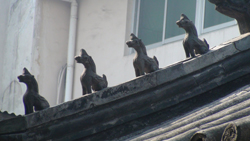Seek knowledge, even as far as China |
 |
<<Click to see original |
A well-known Hadith - or saying attributed to the Prophet Muhammed – says Seek knowledge, even if you have to go to China for it. As Brian Salter has been finding out, Islam has been active in China since the beginning of the 7th century during the Tang Dynasty, just a few decades after the rise of Islam….
China isn’t particularly known for its diverse religions, yet today there are an estimated 250,000 moslems in the Beijing area alone, according to official statistics. When Genghis Khan marched his armies across Asia, he captured many Arabic, Persian and Central Asian peoples. Some of these moslems settled in Beijing and other cities of China; and over time, they were joined by their co-religionists—Tartars, Mongols, Kyrgyz and Uighurs, who intermarried. Their descendents became today's Hui ethnic minority and the most important mosques in Beijing are located in major Hui communities.
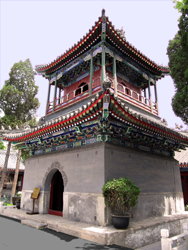
There are in fact around 72 mosques in Beijing - 29 are in the urban districts and 43 in outlying areas; but unlike mosques in the Middle East, Chinese mosques - especially those in Beijing - are often built in the traditional Chinese architectural style, or a subtle blend of Chinese and Arabic styles. If it wasn’t for the many white-hatted moslems who come to pray daily it would be hard to differentiate such mosques from other Chinese temples. (Over the entrance arch of each mosque, one can find the Chinese ideograms for "Temple of the Pure and True Doctrine" - the Mandarin term for a mosque.)
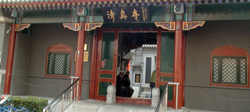
During the Cultural Revolution, all religious activity was forbidden, and many places of worship, of all religions, were damaged or taken over for use as warehouses or factories. It was after 1978 that Islam began its revival in China, along with other religions. In the 1980s, mosques were rebuilt and re-opened with the help of government subsidies. Qur'an schools were recognised and the training of imams resumed, not only in mosques, but also in newly established Islamic institutes throughout the country.
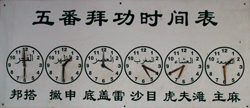
Niujie (Ox Street) Mosque is the oldest and largest masjid in Beijing, originally built in 996, during the Liao Dynasty (916-1125). The local moslem community was forbidden from constructing the mosque in a style other than traditional Chinese architecture, with the exception that the use of Arabic calligraphy was allowed. It was rebuilt in 1442 in the Ming Dynasty and expanded in 1696 under the Qing Dynasty. It has also undergone three renovations since the founding of the People's Republic in 1949. Yet its very survival to the present day seems remarkable in view of all that has occurred in the country over the past half century.
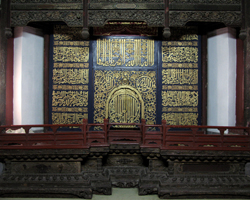
By the 17th century, Ox Street was already an important market for halal beef and mutton and in the vicinity there are a large number of stores and restaurants that have beef and mutton but no pork, in contrast with the rest of the city, where pork is often the preferred meat.
When one enters the Xuanwu District neighbourhood, where some 12,000 of Beijing's moslem community live, the atmosphere changes subtly. The older men wear fur caps and long, fur-edged jackets, and many of the younger women have their heads covered with scarves. Some of the shops have Arabic signs such as "halal meat", or the ideograms for ‘huimin fandian’ - "Moslem people's eating place".

Yet, despite the clues (the Number 10 bus, which stops at Niujie Mosque, even announces the name in Arabic), if one does not read Chinese, it is possible to walk past the Niujie Mosque without realising what it is.
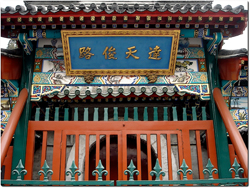
Niujie’s entrance arch has small domes at either end, and an inscription in Arabic as well as in Chinese. Visitors are welcomed, but only Moslems are allowed to enter the main prayer hall. Inside the entrance gate is the ‘Watching Moon Tower’, a hexagonal, two-storied structure, 10 metres tall and housed under a golden-glazed roof. The tower is so named because it was used by the imam to observe the position of the moon to determine times for fasting.
To the east, there is a courtyard garden with a cypress tree and the tomb of the founder of the mosque, said to be an Arab scholar called Nasruddin, as well as the tombs of two sheikhs from Central Asia who visited Beijing in the 13th century. Legend has it that any non-believer who enters the prayer hall will be killed by a hail of ball bearings fired off by the reawakened imams, thus sending him off to meet his maker!
Another mosque worthy of a visit is that of Nan Du Ya - first built in the Yuan Dynasty (1279-1644) with a main entrance, prayer hall and other facilities. Its original entrance had an Islamic lintel with a crescent moon positioned at its apex. Its traditional Chinese style screen wall was 395 metres wide, facing the main entrance of the mosque.
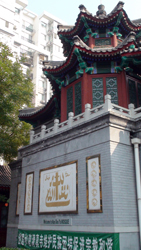
In 2003, however, Nan Du Ya Mosque was relocated to its current position, only about 100 metres southwest of its original site to allow for improvements in Beijing’s infrastructure. The Beijing municipality donated a total of eight million Yuan (4½ million dirhams) and the mosque was newly built in the traditional Chinese courtyard style, covering an area of 1600 square metres. Nan Du Ya is now the best example of how new mosques are built using modern materials and techniques while maintaining traditional Chinese and Islamic styles.

The 15th-century mosque at Dongsi is the second oldest in Beijing and is now the home of the Beijing Islamic Association and Islamic Academy. Many precious cultural relics are preserved here, including a hand-written copy of the Qur’an from the Yuan Dynasty.
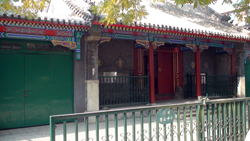
The entrance of Dongsi Mosque faces east; and inside are two gates, a minaret and a prayer hall with three connected quadrangles. There are five wing halls and three wing rooms respectively on the southern and northern parts of the courtyard with ambulatories in front of all of them. Non-moslems, however, are discouraged from entering the complex, and the vast numbers of foreigners that walk along the street outside are totally unaware of what they are passing.
